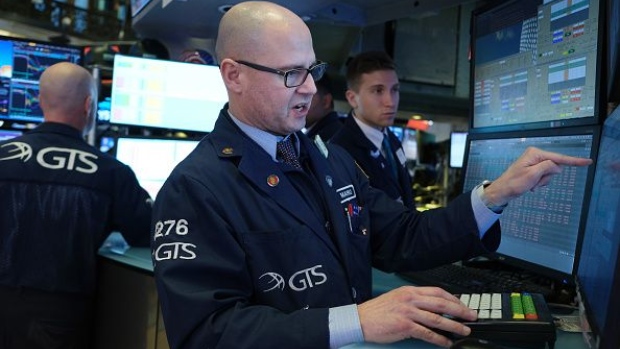Feb 14, 2020
Here’s One Tax Every Candidate Ought to Back
, Bloomberg News

(Bloomberg Opinion) -- This week’s release of President Donald Trump’s budget, with its draconian cuts to the social safety net and unrealistic projections of future growth, has again shined a light on our fiscal challenges. The U.S. clearly needs additional tax revenue to fund vital programs and investments that underlie future economic growth. As no single tax instrument, by itself, is likely to suffice, a number of incremental measures will be required. In this spirit, three Democratic presidential candidates have proposed a financial transaction tax (FTT) to help fund their proposed investments in health care, education, and infrastructure. If properly designed, an FTT would raise substantial revenue, in a progressive fashion, without impeding price discovery or the efficient allocation of capital.
An FTT is a small tax that would apply to trading in stocks, bonds, and derivatives. For example, an FTT of 10 basis points (0.10%) would result in a $10 tax for every $10,000 in stock sold.
This idea is not new. The United Kingdom has had an FTT in the form of a stamp duty since 1694, and several other countries have a version of an FTT now. There are notable successes. Hong Kong raises significant revenue, equivalent to more than 1% of gross domestic product, through its FTT while serving as a critical global financial center. Badly designed FTTs have also produced infamous failures, such as in the case of Sweden, which repealed its excessive FTT in 1991.
The United States can learn from these examples. As set forth in a proposal I recently co-authored with Laura Kawano of the University of Michigan’s Ross School of Business, we recommend a tax of 10 basis points on the trading of equities and most bonds and derivatives. There would be some exclusions, notably for Treasuries and money market instruments. The FTT would include provisions to limit tax avoidance through offshore trading and should be implemented in coordination with other countries. Administrative costs also should be relatively low. In the case of equities, systems already exist to collect a small fee that funds the Securities and Exchange Commission.
Because the United States does not have recent experience with a nontrivial FTT, we recommend the tax be phased-in over four years, starting at 2 basis points and increasing annually. This lag would allow policymakers to calibrate the FTT based on actual data on market effects and avoidance techniques that will inevitably arise.
Why 10 basis points? The FTT is a transaction cost, and relative to current costs, most markets appear capable of absorbing the increase over time. In fact, in many markets a 10 basis point FTT would be less than recent declines in transaction costs. As such, it may simply return costs to levels that prevailed less than a decade ago. While some have argued for an FTT as high as half a percent, such levels appear too high relative to current costs and are unlikely to increase revenue, as an analysis by the Tax Policy Center suggests.
Even at 10 basis points, an FTT would raise significant revenue due to the high volume of financial market transactions. Estimates by the Urban-Brookings Tax Policy Center suggest that the FTT we propose would raise just over $500 billion in its first 10 years and, once fully phased in, $60 billion annually.
Moreover, despite claims by industry lobbyists that an FTT would be a tax on middle-class savings, it would be highly progressive. While not quite a “Robin Hood” tax, taking only from the wealthy or from financial services firms, the FTT falls predominately on those at the top of the income distribution. The effect on lower-income households would be limited: The bottom 20% would face an estimated annual cost of $10, the next 20% a cost of $60, and the middle of the distribution would pay $160 on average. That compares with $12,000 for the top 1% and nearly $48,000 for the top 0.1%. In addition, foreign investors, who are significant holders of U.S. financial securities, also would be subject to the FTT.
The costs incurred by middle-income families could be even lower if an FTT induces them, or the funds through which they invest, to shift to lower turnover, buy-and-hold investments. Most middle-income families make their investments through mutual funds and retirement plans and do not trade directly in individual securities. For a low-turnover index fund, the implied increase in the fund’s annual trading costs due to the FTT, if fully passed on to the investor, is less than 1 basis point. That equates to less than $5 for an average middle-income family with approximately $50,000 in investments.
A fair question is whether, in addition to raising revenue, the tax would actually improve markets by discouraging undesirable activities. Contrary to some claims, there is no strong evidence that an FTT would substantially reduce financial market risks or the probability of future asset price bubbles.
But there is a possible benefit. Trading volumes have exploded over the last two decades, increasing eight-fold in equities. That’s driven to a large degree by innovation — high-frequency trading, algorithmic and quantitative strategies and the like.
A 10 basis point FTT would likely result in a more than 50% reduction in trading volume. If you think high-frequency trading and other trading innovations have been helpful to the efficient allocation of capital, you might not like that result. On the other hand, if you think a lot of that activity is essentially rent-seeking behavior that doesn’t particularly enhance fundamental price discovery or the allocation of capital in the economy, you might be perfectly content.
There are grounds to believe that a reduction in high frequency and algorithmic trading could be a positive development, or at a minimum have limited costs. A study recently published by the Financial Conduct Authority in the UK suggests that some forms of high-frequency trading act as a small tax on investors. And there’s little hard evidence that the explosion in trading activity has done much to enhance the efficiency of capital allocation or increase economic growth.
A properly designed FTT would not, as critics claim, impede the functioning of U.S. markets or threaten our role as a source of innovation or capital formation. Given the significant revenue it could raise, and its strongly progressive distribution, an FTT should be part of any revenue package to fund the public investments that all the current candidates for president, including the incumbent, say they want to make. If it’s not already part of their campaign platforms, it ought to be, for the good of all Americans.
To contact the author of this story: Antonio Weiss at antonio_Weiss@hks.harvard.edu
To contact the editor responsible for this story: James Gibney at avalbrun@bloomberg.net
This column does not necessarily reflect the opinion of Bloomberg LP and its owners.
Antonio Weiss, a senior fellow at the Harvard Kennedy School’s Mossavar-Rahmani Center for Business and Government, served as counselor to the secretary of the Treasury until January 2017.
©2020 Bloomberg L.P.







